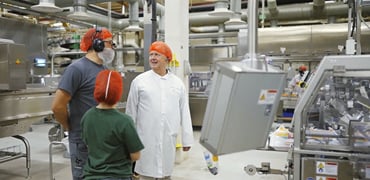2025 Wholegrain Summit calls for action across the food chain

The 2025 International Whole Grain Summit in Germany resulted in a new declaration and five dedicated workstreams, setting a clear direction for the work ahead. One of the most critical workstreams is industry engagement, as the private sector ultimately determines whether wholegrain products are available, affordable, and attractive to consumers.
The mission to inspire people everywhere to eat more wholegrain – and improve public health in the process – continues.
Earlier this year, the 2025 International Whole Grain Summit took place in Germany, gathering leading experts from across the world to discuss how to accelerate wholegrain adoption across the global food chain. According to Caroline Sluyter, Chair of the International Whole Grain Initiative’s governing board, the event marked an important step forward.
“What makes this summit so powerful is that it brings together people who don’t normally sit around the same table. Scientists, industry leaders, policy makers, and health educators. You see experts who have worked in the field for decades sharing ideas alongside students and young professionals, all with an equal chance to contribute. That mix is quite unique,” she says.
Caroline Sluyter explains that the whole grain journey can be divided into two phases:
“At the 2017 Summit, the focus was on identifying research gaps and demonstrating the economic impact of shifting toward wholegrains, building the evidence base that could move policy forward. That was phase one. Now, in phase two, we are widening the circle, bringing in farmers, millers, retailers, and food service providers, while sharpening our messaging to policy makers. If one thing stood out from the 2025 summit, it’s that we must turn strong science into real change across the global food supply.”
A new wholegrain declaration
One of the key outcomes of the 2025 Summit was a new declaration that will guide the International Whole Grain Initiative in the coming years, along with the identification of five workstreams to ensure progress in critical areas. Mikkel Andersen, Global Category Manager and Health & Nutrition Lead at Lantmännen Unibake serves on the Governance Board of the Whole Grain Initiative and also co-leads a new workstream focused on advancing industry engagement.
“The private sector is the real lever for increasing wholegrain consumption. Researchers have already shown the health, cost, and climate benefits, and public health authorities keep recommending wholegrains. Consumers are listening, but if the right products are not available in the right quality, at the right price, and at the right places, they will keep defaulting to refined options. The private sector holds the key to making the healthier choice the easy choice,” says Mikkel Andersen.

The 9th International Whole Grain Summit has not yet been scheduled, but will likely be held in 2029.
Next step in global wholegrain progress defined
The Whole Grain Initiative is a worldwide interdisciplinary collaboration. At the 2025 International Whole Grain Summit, it launched five dedicated workstreams and a new declaration outlining ten priority areas:
- Processing as a tool
Rather than demonizing processing, the focus should be on scientifically informed processing that enhances nutrition, safety, and sensory appeal. - Affordability & economic incentives
The cost barrier is a major obstacle. Strategies include subsidies, achieving cost-parity between whole and refined grains, and investment along the value chain. - “Health by stealth” reformulation
Gradual increases in whole grain content (so taste and texture remain familiar) are more acceptable to consumers; even small shifts can yield health benefits.
- Lead with taste in communications
Messaging should foreground flavor, enjoyment, ease of use, not just health. Engaging with influencers, chefs, social media, and family audiences is encourage. - Improve labeling & definitions
Harmonize around the Whole Grain Initiative’s (WGI) definition of whole grains. Current labeling and nutrient profiling systems often rely on fiber as a proxy, which can blur distinctions.
- Start early, influence children & institutions
Schools and institutional meal programs provide opportunities to normalize wholegrain habits in children, which can persist long term.
- Use sustainability messaging
Wholegrains can be part of climate-friendly, plant-centered diets. That narrative is underutilized and should be developed further.
- Cross-sector collaboration
Effective change depends on partnerships among governments, NGOs, industry, academia, media, and retailers. Shared standards and coordinated actions are key.
- Policy, regulation & fiscal tools
Governments can drive change via incentives (tax breaks, subsidies), standards, and regulatory frameworks that support reformulation and wholegrain investments.
- A unified, positive narrative
A coherent, optimistic story is needed. One that frames wholegrains as delicious, modern, accessible, healthy, and sustainable and resonates across cultures.




















